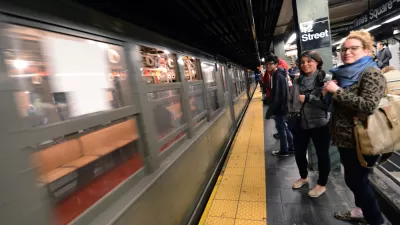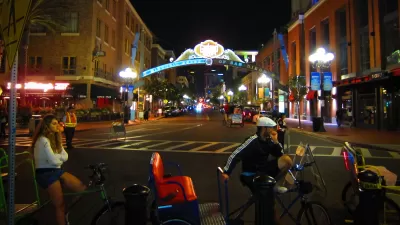Despite significant investment in transit infrastructure, and renewed interest in downtowns and walkable neighborhoods, new data shows that gains in transit commute mode share have been hard to come by in America’s largest cities, says Kaid Benfield.
"As most readers know only too well, the US pales by comparison to the rest of the world when it comes to getting around by anything other than single-occupancy cars," writes Benfield in a recent blog post. He adds, "[s]lowly but surely, the trend is now beginning to reverse as the hot markets are in downtowns and walkable neighborhoods, with the ones having good transit service commanding the highest premiums on a per-square-foot basis."
Despite these new trends, Benfield finds mixed results in the findings of a recent analysis examining 2011 American Community Survey results regarding metropolitan commuting patterns. Only New York City and Washington D.C, who lead in general transit usage with commute mode shares of 31.1 percent and 14.8 percent, respectively, significantly increased their transit mode shares in the last decade. New York, Boston and San Francisco all led the way in walking to work, with shares of 6.3 percent, 5.3 percent and 4.3 percent, respectively.
Nationwide, bike commuting is still relatively low, with most cities registering fewer than 2 percent shares. Portland (topping the list) and three Californian cities (the Bay Area, San Jose/Silicon Valley, and Sacramento) were the exceptions. Of interest, notes Benfield, is the finding that the 10 longest commutes all average around 30 minutes, a statistic that "has been fairly stable for centuries; only the modes and distances have changed."
FULL STORY: Which US metros have the greenest commuting habits?

Alabama: Trump Terminates Settlements for Black Communities Harmed By Raw Sewage
Trump deemed the landmark civil rights agreement “illegal DEI and environmental justice policy.”

Planetizen Federal Action Tracker
A weekly monitor of how Trump’s orders and actions are impacting planners and planning in America.

The 120 Year Old Tiny Home Villages That Sheltered San Francisco’s Earthquake Refugees
More than a century ago, San Francisco mobilized to house thousands of residents displaced by the 1906 earthquake. Could their strategy offer a model for the present?

In Both Crashes and Crime, Public Transportation is Far Safer than Driving
Contrary to popular assumptions, public transportation has far lower crash and crime rates than automobile travel. For safer communities, improve and encourage transit travel.

Report: Zoning Reforms Should Complement Nashville’s Ambitious Transit Plan
Without reform, restrictive zoning codes will limit the impact of the city’s planned transit expansion and could exclude some of the residents who depend on transit the most.

Judge Orders Release of Frozen IRA, IIJA Funding
The decision is a victory for environmental groups who charged that freezing funds for critical infrastructure and disaster response programs caused “real and irreparable harm” to communities.
Urban Design for Planners 1: Software Tools
This six-course series explores essential urban design concepts using open source software and equips planners with the tools they need to participate fully in the urban design process.
Planning for Universal Design
Learn the tools for implementing Universal Design in planning regulations.
Clanton & Associates, Inc.
Jessamine County Fiscal Court
Institute for Housing and Urban Development Studies (IHS)
City of Grandview
Harvard GSD Executive Education
Toledo-Lucas County Plan Commissions
Salt Lake City
NYU Wagner Graduate School of Public Service




























